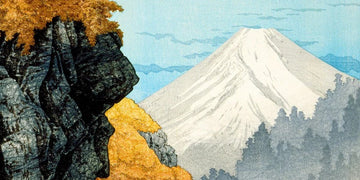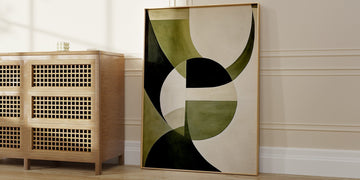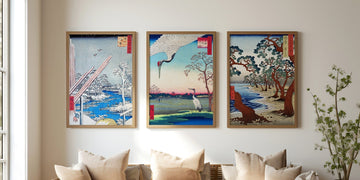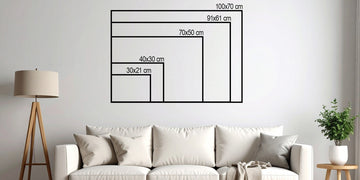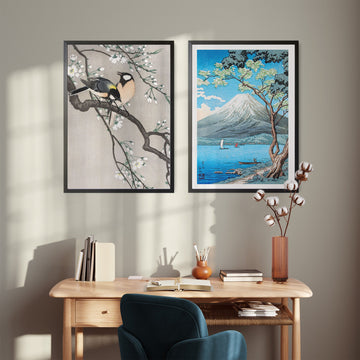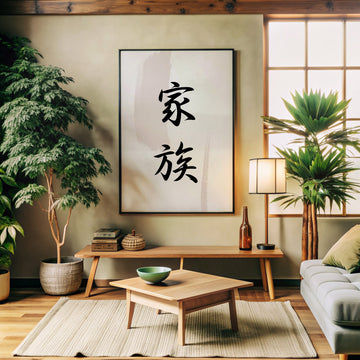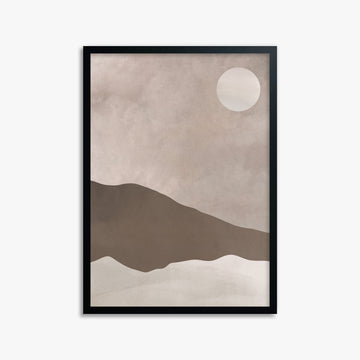Picture this: you're walking through the bustling streets of old Tokyo (then called Edo) in the 1700s, and you stumble upon colorful prints hanging in shop windows. These aren't just any pictures – they're ukiyo-e, literally meaning "pictures of the floating world," and they're about to change art forever. What makes these prints so special isn't just their stunning beauty, but the incredible story of how they captured thes pirit of an entire era and eventually took the world by storm.
What Was This "Floating World" Anyway?
The term "floating world" has a fascinating backstory. Originally, "ukiyo" meant something quite sad – the Buddhist idea that life is fleeting and full of suffering. But during Japan's Edo period (1603-1868), clever people gave this concept a complete makeover. They kept the idea of life being temporary, but instead of moping about it, they decided to enjoy every moment. The "floating world" became all about embracing life's pleasures – theater, fashion, romance, and good times in general.
This transformation happened during one of the most peaceful and prosperous times in Japanese history. After centuries of civil wars, Japan finally had stability under the Tokugawa rulers. Cities grew huge, especially Edo, which became home to over a million people – making it one of the world's biggest cities at the time. People had money to spend, time to enjoy themselves, and a hunger for entertainment.
The heart of this floating world was found in special entertainment districts like Yoshiwara in Edo. Thesewere like ancient Soho – places where the normal rules didn't apply, where you could see kabuki theater, meet famous courtesans, and experience the latest trends in fashion and culture. It was in this exciting, slightly rebellious atmosphere that ukiyo-e was born.
From Simple Prints to Art Revolution

The Early Days (1670s-1740s)
Ukiyo-e started pretty humbly with an artist named Hishikawa Moronobu in the late 1600s. He's often called the "father of ukiyo-e," and for good reason – his black and white prints of beautiful women and street scenes basically invented the whole genre. His most famous work, "Looking Back Beauty," shows a woman glancing over her shoulder with such grace and style that it still takes your breath away today.
Back then, these prints were simple affairs – just black ink on paper, though sometimes artists would add a splash of red or yellow by hand. The process was labor-intensive and expensive, but it was still way cheaper than commissioning a painted scroll from a court artist.
The Color Explosion (1740s-1765)
Things got really exciting when artists figured out how to print in multiple colors. At first, they could only manage two or three colors – usually red and green – but even this was revolutionary. Then came 1765, and everything changed.
Suzuki Harunobu cracked the code for full-color printing, creating what they called nishiki-e or "brocade prints" because they were as beautiful as expensive silk brocades. This wasn't just about pretty colors – it required incredible technical skill. Each color needed its own wooden block, and they all had to line up perfectly when printed. Imagine trying to do a 1000-piece jigsaw puzzle, except if you get one piece wrong, the whole picture is ruined.
The Golden Years (1780s-1810s)
The late 1700s and early 1800s were ukiyo-e's absolute peak. This is when the superstars emerged – artists whose names are still household words today (well, at least in art-loving households).
Kitagawa Utamaro revolutionized portraits of beautiful women with his incredibly detailed close-ups thatshowed not just physical beauty but real personality and emotion. Then there was the mysterious Tōshūsai Sharaku, who appeared out of nowhere in 1794, created about 140 amazing portraits of kabuki actors in just ten months, and then vanished completely. His portraits were so brutally honest – showing actors with all their flaws and quirks – that they shocked people at the time but are now considered masterpieces.
When Landscapes Took Over (1830s-1850s)
Just when everyone thought ukiyo-e was all about people, along came Katsushika Hokusai and Utagawa Hiroshige to prove them wrong. Hokusai's "Thirty-six Views of Mount Fuji" series, featuring the world-famous "Great Wave off Kanagawa," showed that landscapes could be just as exciting as portraits of beautiful women or famous actors.
Hiroshige took this even further with his "Fifty-three Stations of the Tōkaidō," capturing the beauty of Japan's most important highway, for example the Fukushima Station. These weren't just pretty pictures – they were like travel brochures, guidebooks, and art all rolled into one. People bought them as souvenirs, travel inspiration, and just because they were gorgeous.
The Different Types of Ukiyo-e
Beautiful Women (Bijin-ga)
This was the bread and butter of ukiyo-e. Artists created idealized portraits of women – sometimes famous courtesans who were like the movie stars of their day, sometimes just everyday women going about their lives. Masters like Utamaro didn't just paint pretty faces; they captured real emotions and personalities that made viewers feel like they knew these women personally.
Actor Portraits (Yakusha-e)
Kabuki actors were the rock stars of Edo Japan, and their portraits were like concert posters and fan magazines combined. These prints advertised upcoming plays while celebrating the actors themselves. The Torii school of artists specialized in these theatrical subjects, creating dramatic images that captured all the excitement of live performance.
Famous Places (Meisho-e)
As Japan became more peaceful and prosperous, people started traveling for pleasure. Landscape prints became incredibly popular, showing famous temples, beautiful mountains, and scenic spots along Japan's highways. These served as both art and travel guides, inspiring people to visit the places they depicted.
Birds and Flowers (Kachō-e)
Influenced by Chinese art traditions, these elegant nature studies usually featured a single bird withcomplementary plants or flowers. They were all about harmony and natural beauty, offering a peaceful contrast to the busy human world depicted in other ukiyo-e genres.
Warriors and Heroes (Musha-e)
These action-packed prints showed legendary warriors, historical battles, and mythological heroes. Utagawa Kuniyoshi was the undisputed master of this genre, creating dynamic compositions full of movement and fantastic details that were like the superhero comics of their day.
Adult Content (Shunga)
Though often glossed over in museum exhibitions, erotic prints were actually a huge part of ukiyo-e production. Far from being crude, these sophisticated works often contained humor, tenderness, and social commentary. Nearly every major ukiyo-e artist created shunga, and they often showcased the finest printing techniques available.
How Were These Amazing Prints Made?
Creating ukiyo-e was a team effort involving four key players:
- The Publisher: Like a modern movie producer, they came up with ideas, hired talent, and handledmarketing and distribution
- The Artist: Created the original design and concept
- The Carver: Translated the artist's drawing into carved wooden blocks (one for each color!)
-
The Printer: Applied the inks and created the final prints
This collaboration meant that each person could focus on what they did best, resulting in incredibly high-quality prints that could be produced efficiently and sold at reasonable prices.
Taking the World by Storm
The Journey West
When Japan opened its doors to the West in the 1850s after centuries of isolation, ukiyo-e prints initially arrived in Europe almost by accident – they were used as packing material for other goods! But Western artists immediately recognized something special. Masters like Monet, Van Gogh, and Degas were blown away by the bold compositions, flat perspective, and brilliant colors that were completely different from European art traditions.
This influence, called "Japonisme," completely changed the direction of Western art, contributing to movements like Impressionism and Art Nouveau. Van Gogh was so inspired that he created his own versions of famous ukiyo-e prints, and you can see ukiyo-e's influence throughout his later work.
Keeping the Tradition Alive
When Japan modernized in the late 1800s, ukiyo-e faced a crisis. Photography and Western printing techniques threatened to make woodblock printing obsolete. But two movements emerged to keep thetradition alive:
Shin-hanga (New Prints): Publishers worked with artists to create prints that appealed to both Japanese and Western collectors while maintaining traditional techniques.
Sōsaku-hanga (Creative Prints): Artists took complete control of the process, designing, carving, and printing their own works.
Modern Impact
Today, ukiyo-e's influence is everywhere. You can see it in manga and anime, graphic design, fashion, and contemporary art. Museums around the world regularly hold ukiyo-e exhibitions that draw huge crowds, proving that these "pictures of the floating world" still have the power to captivate audiences centuries after they were created.
Japandi style remixes also keep these arts current and are popular pieces among home decor enthusiast.
The Greatest Hits and Artists
Let's talk about some of the absolute legends and their masterpieces:
Hishikawa Moronobu: His "Looking Back Beauty" basically invented the ukiyo-e style and is still one ofthe most elegant images ever created.
Suzuki Harunobu: "Lovers Walking in the Snow" showcased the new full-color printing technique with aromantic scene that's both tender and technically brilliant.
Kitagawa Utamaro: "Three Beauties of the Present Day" revolutionized how artists depicted women,focusing on individual personality rather than generic beauty.
Tōshūsai Sharaku: "Otani Oniji III as Yakko Edobei" shows his incredible ability to capture not just howactors looked, but their entire personality and stage presence.
Katsushika Hokusai: "The Great Wave off Kanagawa" is probably the most famous Japanese artwork inthe world, and for good reason – it perfectly captures the power and beauty of nature.
Utagawa Hiroshige: "Sudden Shower over Shin-Ōhashi Bridge" demonstrates his mastery of atmosphereand weather effects that influenced Impressionist painters decades later.
Utagawa Kuniyoshi: "Takiyasha the Witch and the Skeleton Specter" brings fantasy and mythology to life with incredible drama and technical skill.
Why Ukiyo-e Still Matters
Ukiyo-e represents something truly special in art history – a time when commercial art achieved transcendent beauty, when ordinary people's desires drove artistic innovation, and when one culture created something that spoke to the entire world. These prints started as affordable entertainment for regular folks but ended up influencing the greatest artists of the West and establishing Japan's reputationas a cultural powerhouse.
The original "floating world" of Edo-period Japan may be long gone, but its pictures continue to float through time, carrying their message of beauty, pleasure, and the bittersweet awareness that all things pass. In our own rapidly changing world, these images remind us to appreciate fleeting moments of beauty – perhaps the most enduring lesson from the pictures of the floating world.
Whether you're an art lover, a history buff, or just someone who appreciates beautiful things, ukiyo-e offers something magical: a window into a world where art, entertainment, and daily life came together to create something truly extraordinary. The floating world may have been temporary, but its pictureshave achieved a kind of immortality that their creators could never have imagined.
Want to Know More?
Start with the Met's online collection if you're new to ukiyo-e – their descriptions are perfect for beginnersand their image quality is outstanding. The British Museum also has an extensive collection of ukiyo-e art. Once you're hooked (and you will be!), plan a visit to see some originals in person. The Rijksmuseum, Amsterdam in Europe, the Museum of Fine Arts, Boston in North-America and the Tokyo National Museum in Asia have some fantastic collections. There's nothing quite like seeing the actual texture and colors of a 200-year-old print.
When you are ready to put a piece of art history into your own environment, check out our affordable ukiyo-e poster prints to hang on your walls. Original prints are also often available - albeit at much higher price point - at some galleries and auctions.

